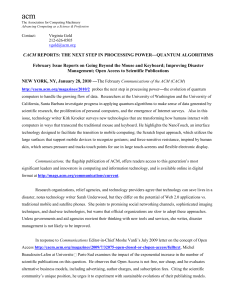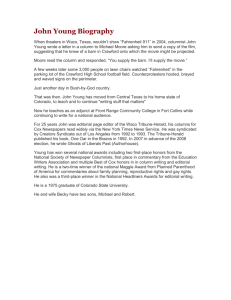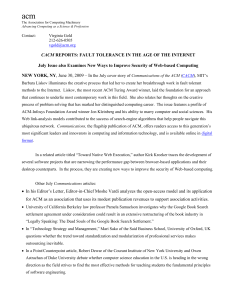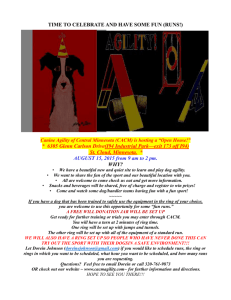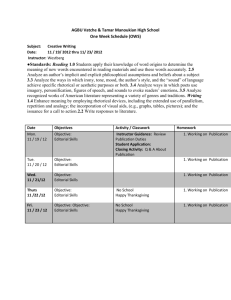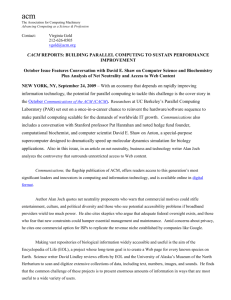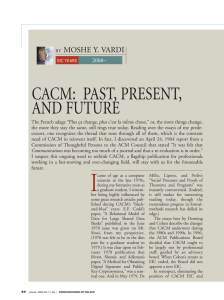CACM Revamped
advertisement
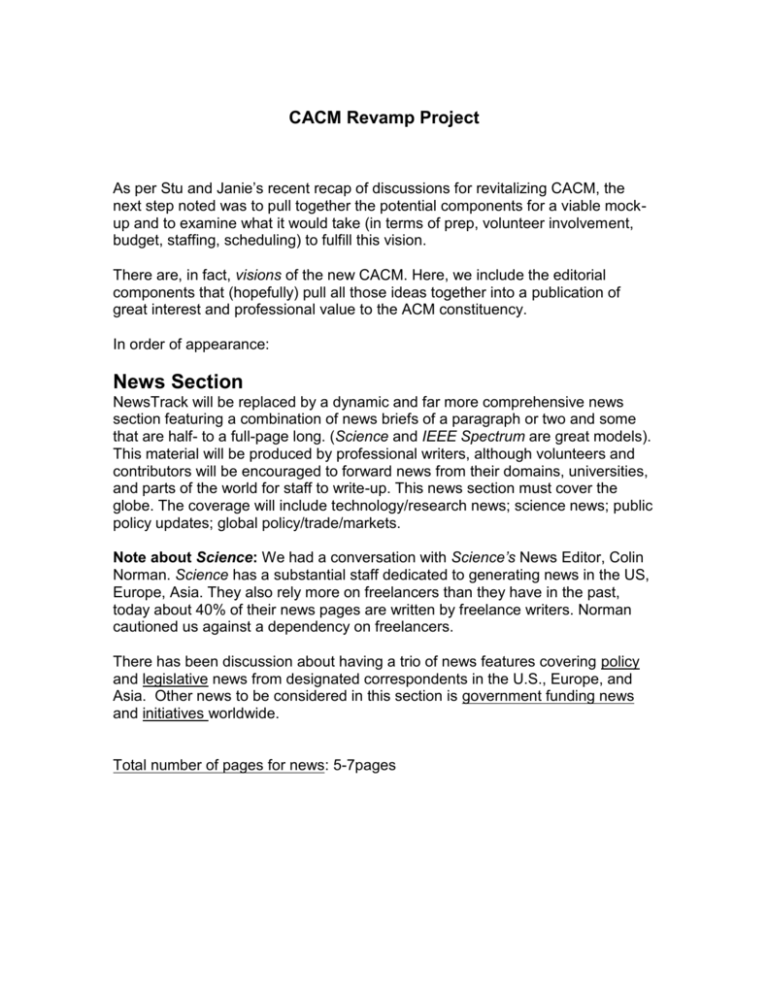
CACM Revamp Project As per Stu and Janie’s recent recap of discussions for revitalizing CACM, the next step noted was to pull together the potential components for a viable mockup and to examine what it would take (in terms of prep, volunteer involvement, budget, staffing, scheduling) to fulfill this vision. There are, in fact, visions of the new CACM. Here, we include the editorial components that (hopefully) pull all those ideas together into a publication of great interest and professional value to the ACM constituency. In order of appearance: News Section NewsTrack will be replaced by a dynamic and far more comprehensive news section featuring a combination of news briefs of a paragraph or two and some that are half- to a full-page long. (Science and IEEE Spectrum are great models). This material will be produced by professional writers, although volunteers and contributors will be encouraged to forward news from their domains, universities, and parts of the world for staff to write-up. This news section must cover the globe. The coverage will include technology/research news; science news; public policy updates; global policy/trade/markets. Note about Science: We had a conversation with Science’s News Editor, Colin Norman. Science has a substantial staff dedicated to generating news in the US, Europe, Asia. They also rely more on freelancers than they have in the past, today about 40% of their news pages are written by freelance writers. Norman cautioned us against a dependency on freelancers. There has been discussion about having a trio of news features covering policy and legislative news from designated correspondents in the U.S., Europe, and Asia. Other news to be considered in this section is government funding news and initiatives worldwide. Total number of pages for news: 5-7pages COLUMNS The front section of the magazine typically includes columns and departments of technical interest. There are many options and opportunities to explore new topics and new voices. Moreover, some of the current CACM quarterly columns are read regularly by 70% or more of the ACM audience, according to readership surveys over the last five years. For that reason we may want to consider retaining the most popular existing columns. Those would be: Commentary (or a Point/Counterpoint treatment). A soundly reasoned argument always grabs reader attention. The topic must be timely; the debate one that draws all sectors of the CS community. Practical Programmer—Robert Glass (or a new author) This column is currently read by 75% of the CACM audience. Glass likes to put a mirror up to academics and practitioners; often depicting all the ways their worlds—and work—are as similar as they are dissimilar. The Business of Software—Philip Armour This column is often viewed as an abbreviated case study in software engineering and development projects. IT as a Profession—P.J. Denning Denning addresses ways to think about the computing field—or segments of it— as well as practices that make the IT professional more effective. Legally Speaking—Pam Samuelson CACM was the first computing publication to feature a column devoted to intellectual property rights and other legal ramifications spurred by technology. The goal of this column is to translate the legalese for the computer science community (and vice versa). It is unlikely these existing contributors will agree to anything more frequent than a quarterly column. One of these columns per issue could be slated. (These authors are each paid an honorarium of $500 per column). Peter Neumann’s monthly “Inside Risks” column has been a staple feature for the last page of CACM since July 1990. Another highly rated CACM feature. This might be interchanged with a book review every quarter. Column Ideas to consider: Reviving Programming Pearls—Programming is about the only common thread the ACM audience has in common. Although it ceased publication in 1987, it is still recognized as one of CACM’s greatest columns. Another potential turn-to feature might be a monthly brainteaser (programming/math/algorithmic) or think piece that gets readers actively involved in finding the solution. The CACM audience loves a challenge. Total page count for columns material = 10-13 pages Computing Practices (or Best of Best Practices) Section Given ACM membership is 80% practitioner-based, and that more than half the readership find the current content to be professionally worthwhile—particularly in the management ranks—it would appear a sound argument not to eliminate all such material from the next generation of CACM. These are real-world, problemsolving or best practices pieces that are typically no more than 5-7 (magazine) pages. Two or three of these articles per issue (depending on space) would offer a more well-rounded editorial fare. CACM has a healthy queue of accepted manuscripts. Any future submissions of technical articles or practical computing matters would only be considered if they covered new territory, new apps, new technologies. Much of the current backlog (the result of three years of an unprecedented number of submissions) will be published in CACM Virtual Extensions. These are online-only publications have been employed when needed as a way to speed up the publication schedule for authors. Since the online articles are treated as extensions of a particular print edition, authors can still cite volume, number, and even page numbers. CACM has published approximately 100 articles in virtual extensions since 1996. Total pages for technical articles section = 20-25 pages Best of the Best (or) Research and Discovery Section As discussed, drawing top research articles back into the fold may best be served initially by tapping ACM conferences and ACM journals for some of the best papers from their most recent meets and/or issues. HQ will send requests to key ACM conference program chairs (“key” to be determined by a CACM editorial board) and eics asking they pick the top 2-3 papers from their meet or recent issues. Research chosen for publication will be preceded by a well-written, well-rounded one-page summary (a la Science magazine’s “Perspectives”). This summary will speak to the audience, most of who may not be expert in the particular research discipline to follow but would surely be interested in how the work affects their work. Program chairs and eics will be given specific criteria for paper selection. Among the key measures they should consider: Selection should tap best papers for a general audience; that is, research best suited to or most likely appreciated by a diverse audience rather than a specific discipline. Content should strive to focus on new advancements, new findings. Also to consider in this mix are “Big Idea” papers as noted in one of Dave Patterson’s first President’s Letters (“The Health of Research Conferences and the Dearth of Big Idea Papers,” CACM, Dec. 2004, 23-24). These are the research pieces typically submitted to major conferences that do not fit any particular technical track. They tend to be bolder in nature, focusing on new directions or new ways to think about a research project. Just papers might be extremely valuable to the CACM audience and/or could spark scientific debate. Program chairs must also be alerted (by HQ) to the editorial interest in these manuscripts, even if they do not make the conference cut. Selections should be global in scope and interest. Selections should be of a manageable length for magazine inclusion; that is, very lengthy research papers (over 12-15 pages) do not translate to a broad-based publication and cannot be accommodated by the monthly page allotment. Note: Several ACM journals (inc. Computing Surveys) regularly publish research papers in the 30-50+ page range. We may want to consider an abbreviated version—or a “Perspectives” treatment only— of this research with a url pointer to the complete version. Conference program chairs and eics will be asked to nominate potential authors to write the one-page “Perspectives” summaries. Authors and, of course, the CACM Editorial Board will also be approached for recommendations. The mock-up for market research should have at least one more example to give the test market groups a feel for the editorial that will make up a good portion of each monthly issue. Given the time frame, conferences to consider approaching in the next coming months include: WWW (May 23-26) ISCA (June 17-21) DAC (July 24-28) SIGGRAPH (July 30-Aug.3) SC ’06 (Nov. 11-17) New research submissions submitted directly to CACM will also be considered. Author guidelines and house ads will be published online and in print issues noting criteria for new submissions. Ultimate selection of the research papers to be published in CACM will be the responsibility of the Editorial Board (possibly in conjunction with outside reviewers and experts from which they have solicited comments). Note about Science: Science editors commission Perspectives, but unsolicited contributions are considered on occasion. Deputy Editor Katrina Kelner told us it typically takes about 4 weeks for Perspective piece to be finalized. There are usually about 30+ Perspectives “in the hopper” at any one time. Total pages for the research section = 35-40 ages. Redesign A redesign offers a clean slate, in this case a less cluttered look, less complementary art, defined sections for help readers find what they are looking for, stronger typefaces. A full magazine redesign can take six or more weeks to create and run upwards of $20-25K. Total page count: The sections here represent about 70-85 editorial pages. Add to the count the monthly musts = mastheads, membership app, display ads, house ads, calendar of events, and career opportunities and the typical issue will run between 96-112 pages. Editorial Board All references here to the CACM Editorial Board are in respect to a new Editorial Board of volunteers who will play a far more hand-on role in the creation of each issue than has been the case for quite some time. This board will be international in scope and outreach. It will be responsible for setting the editorial direction of CACM, for identifying the research and the potential authors to pursue, for opening doors and encouraging editorial submissions for consideration. Board members must represent the key CS disciplines and have far-reaching connections in their field of expertise. Again, their perspective (and efforts) must be global. Moshe Vardi has agreed to spearhead this effort; however, his schedule is such that he cannot turn to this project until early September. Next Steps Should Council endorse moving forward on this project, the next steps would include: 1. Build a real mock-up of a new CACM for market research (focus groups, interviews) to test the concept. - We will need a larger set of Perspective papers (best of research) - We will need an example of the "practitioners" piece (best of best practices?) - We will need good examples of the kind of "news" we want. - We will need good descriptions of the kind of "columns" we want. To do this step will likely require insight and guidance from the volunteer EIC for new CACM. 2. With the new mock-up, we need to conduct serious market research (with members and non members). Goal of this research is to test the concept and see if we have a seriously more engaging publication. 3. Develop a business plan to assess cost. 4. Develop a launch/transition plan 5. Complete the Editorial Board 6. Begin to create the new CACM. Estimated Costs* Mockup and market research including focus groups and interviews: $100K. Complete CACM redesign $20-25K News section prep options: Hire dedicated senior news writer to produce the news section each month $75K-$85K. Contracting a news service to prepare the news as per our direction and coverage needs $25K-$30K per year. If need be, supplement with a similar service overseas to ensure comprehensive coverage. Freelancers would be commissioned on an as-need basis: ($1,000 to $1,500 per article). Anticipated Savings: By keeping CACM to a page budget between 96-112 per issue (instead of current 128-136) per issue will we realize a savings of $300K+ that can be reallocated to help finance the revitalization. *Please note at this stage the costs we can most closely estimate pertain to producing a mockup and conducting market research. The ultimate feedback from those efforts will help us develop a business plan with as accurate a cost model as possible.
